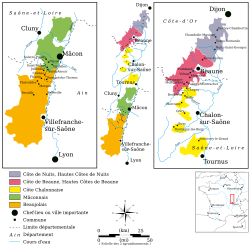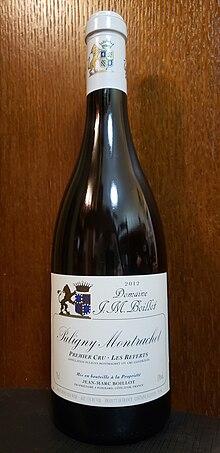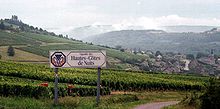Burgundy wine
| Wine region | |
 | |
| Official name | Bourgogne |
|---|---|
| Type | wine region |
| Year established | AOC in 1936 |
| Country | France |
| Sub-regions |
|
Aligoté | |
| Official designation(s) | Regional, Village, 1er cru and Grand cru |
| Comments | |
The Climats, terroirs of Burgundy | |
| Criteria | Cultural: (iii)(v) |
| Reference | 1425-001 |
| Inscription | 2015 (39th Session) |
| Area | 13,118 ha (50.65 sq mi) |
| Buffer zone | 50,011 ha (193.09 sq mi) |
| Coordinates | 47°3′29″N 4°51′52″E / 47.05806°N 4.86444°E |
Burgundy wine (
Red and white wines are also made from other grape varieties, such as
Burgundy has a higher number of
Geography and climate
The Burgundy region runs from
There are 100 appellations in Burgundy and these are classified into four quality categories. These are Bourgogne, village, premier cru and grand cru.
Further south is the
Below the Côte Chalonnaise is the Mâconnais region, known for producing large quantities of easy-drinking and more affordable white wine. Further south again is the Beaujolais region, famous for fruity red wines made from Gamay grapes.
Burgundy's terrain is
History
This section needs additional citations for verification. (December 2010) |

Archaeological evidence establishes
Monks and monasteries of the Roman Catholic Church have had an important influence on the history of Burgundy wine. The first known donation of a vineyard to the church was by king
Since Burgundy is land-locked, very little of its wine left the region in Medieval times, when wine was transported in
The status of Burgundy wines continued in the court of the
In the 18th century, the quality of roads in France became progressively better, which facilitated commerce in Burgundy wines. The first
After Burgundy became incorporated in the Kingdom of France, and the power of the church decreased, many vineyards which had been in the church's hands were sold to the bourgeoisie from the 17th century. After the

The awareness of the difference of quality and style of Burgundy wines produced from different vineyards goes back to Medieval times, with certain climats being more highly rated than others. An early author on this aspect of Burgundy wines was Denis Morelot with his La Vigne et le Vin en Côte d'Or from 1831. In 1855, the same year as the famous Bordeaux Wine Official Classification was launched, Dr. Jules Lavalle published an influential book, Histoire et Statistique de la Vigne de Grands Vins de la Côte-d'Or, which included an unofficial classification of the Burgundy vineyards in five classes and which built on Morelot's book. In decreasing order, Lavalle's five classes were hors ligne, tête de cuvée, 1ère cuvée, 2me cuvée and 3me cuvée.[7] Lavalle's classification was formalized in modified form by the Beaune Committee of Agriculture in 1861, and then consisted of three classes. Most of the "first class" vineyards of the 1861 classification were made into Grand Cru appellations d'origine contrôlées when the national AOC legislation was implemented in 1936.[1]
Burgundy wine has experienced much change over the past 75 years. Economic depression during the 1930s was followed by the devastation caused by World War II. After the War, the vignerons returned home to their unkempt vineyards. The soils and vines had suffered and were sorely in need of nurturing. The growers began to fertilize, bringing their vineyards back to health. Those who could afford it added potassium, a mineral fertilizer that contributes to vigorous growth. By the mid-1950s, the soils were balanced, yields were reasonably low and the vineyards produced some of the most stunning wines in the 20th century.
For the next 30 years, they followed the advice of renowned viticultural experts, who advised them to keep spraying their vineyards with chemical fertilizers, including potassium. While a certain amount of potassium is natural in the soil and beneficial for healthy growth, too much is harmful because it leads to low acidity levels, which adversely affect the quality of the wine.
As the concentration of chemicals in the soil increased, so did the yields. In the past 30 years, yields have risen by two-thirds in the appellations contrôlées vineyards of the Côte d'Or, from 29 hectoliters per hectare (hl/ha) (yearly average from 1951 to 1960) to almost 48 hl/ha (1982–91), according to a study by the Institut National des Appellations d'Origine. With higher yields came wines of less flavor and concentration.[citation needed] Within 30 years, the soils had been significantly depleted of their natural nutrients.
The period between 1985 and 1995 was a turning point in Burgundy. During this time, many Burgundian domaines renewed efforts in the vineyards and gradually set a new course in winemaking, producing deeper, more complex wines. Today, the Burgundy wine industry is reaping the rewards of those efforts.
Wine characteristics and classification



Burgundy is in some ways the most terroir-oriented region in France; immense attention is paid to the area of origin, and in which of the region's 400 types of soil a wine's grapes are grown. As opposed to Bordeaux, where classifications are producer-driven and awarded to individual chateaux, Burgundy classifications are geographically focused. A specific vineyard or region will bear a given classification, regardless of the wine's producer. This focus is reflected on the wine's labels, where appellations are most prominent and producers' names often appear at the bottom in much smaller text.
The main levels in the Burgundy classifications, in descending order of quality, are:
- Grand Cru wines are produced by a small number of the best vineyard sites in the Côte d'Or region, as strictly defined by the AOC laws. These Cru wines make up 2% of the production at 35 hl/ha, and are generally produced in a style meant for cellaring, and typically need to be aged a minimum of five to seven years. The best examples can be kept for more than 15 years. Grand Cru wines will only list the name of the vineyard as the appellation - such as Corton or Montrachet - on the wine label, plus the Grand Cru term, but not the village name.[11] Several Grand Cru vineyards have compound names (double-barrelled names), mostly due to adding a more famous vineyard which they neighbor, as in Charmes-Chambertin (adding Chambertin to "Charmes") or Romanée-Saint-Vivant (adding La Romanée to "Saint-Vivant"; these no longer quite neighbor), though other compound names such as Corton-Charlemagne have idiosyncratic histories. There are two triple names of this form: Bienvenues-Bâtard-Montrachet and Criots-Bâtard-Montrachet, corresponding to vineyards that neighbor Bâtard-Montrachet, which neighbors Montrachet. Compound names using a more famous vineyard are sometimes referred to as "satellites" of the more famous one.[12][13]
- Premier Cru wines are produced from specific vineyard sites that are still considered to be of high quality, but not as well regarded as the Grand Cru sites. Premier Cru wines make up 12% of production at 45 hl/ha. These wines often should be aged three to five years, and again the best wines can keep for much longer. Premier Cru wines are labelled with the name of the village of origin, the Premier Cru status, and usually the vineyard name, for example, "Volnay 1er Cru Les Caillerets". Some Premier Cru wines are produced from several Premier Cru vineyards in the same village, and do not carry the name of an individual vineyard.[14] Blending premier crus is more common in Morey-Saint-Denis than other villages.[15]
- Village appellation wines are produced from a blend of wines from supposedly lesser vineyard sites within the boundaries of one of 42 villages, or from one individual but unclassified vineyard. Wines from each different village are considered to have their own specific qualities and characteristics,[9][10] and not all Burgundy communes have a village appellation. Village wines make up 36% of production at 50 hl/ha. These wines can be consumed two to four years after the release date, although again some examples will keep for longer. Village wines will show the village name on the wine label, such as "Pommard", and sometimes - if applicable - the name of the single vineyard or climat where it was sourced.[16] Several villages in Burgundy have appended the names of their most famous Grand Cru vineyards to the original village name, for marketing reasons, resulting in double-barrelled names, starting with "Gevrey-Chambertin" in 1847 and ending with "Morey-Saint-Denis" in 1927.[17]
- Regional appellation wines are wines which are allowed to be produced over the entire region, or over an area significantly larger than that of an individual village.[18] At the village, Premier Cru and Grand Cru levels, only red and white wines are found, but some of the regional appellations also allow the production of rosé and sparkling wines, as well as wines dominated by grape varieties other than Pinot noir or Chardonnay.[8] These appellations can be divided into three groups:

- AOC Bourgogne, the standard or "generic" appellation for red or white wines made anywhere throughout the region, and represent simpler wines which are still similar to the village. These wines may be produced at 55 hl/ha. These wines are typically intended for immediate consumption, within three years after the vintage date.
- Subregional (sous-régional) appellations cover a part of Burgundy larger than a village. Examples are Bourgogne Hautes-Côtes de Beaune, Bourgogne Hautes-Côtes de Nuits and Mâcon-Villages.[18] Typically, those communes which do not have a village appellation will have access to at least one subregional appellation. This level is sometimes described as intermediate between AOC Bourgogne and the village level.
- Wines of specific styles or other grape varieties include white Crémant de Bourgogne.
Chablis wines are labeled using a similar hierarchy of Grand Cru, Premier Cru, and Village wines, plus Petit Chablis as a level below Village Chablis. Wines from Beaujolais are treated still differently.
In general, producers are always allowed to declassify their wine in steps to a lower-ranked AOC if they wish to do so. Thus, a wine from a Grand Cru vineyard may be sold as a Premier Cru from that vineyard's village, a Premier Cru wine may be sold as a Village wine, and so on. This practice will almost invariably mean the declassified wine will have to be sold at a lower price, so this is only practiced when something is to be gained overall in the process. One motive may be to only include vines of a certain age in a Grand Cru wine, to improve its quality and raise its prestige and price, in which case the wine coming from younger vines may be sold as a Premier Cru at a lower price. Overall, such a practice may allow a producer to keep a higher average price for the wine sold.
In total, around 150 separate AOCs are used in Burgundy, including those of Chablis and Beaujolais.
Production
In 2003, the Burgundy vineyards (including Chablis but excluding Beaujolais) covered a total of 28,530 hectares (70,500 acres).[1] Côte d'Or as a whole, including Hautes Côtes de Beaune and Hautes Côtes de Nuits, covered 8,000 hectares (20,000 acres), of which the heartland of Côte de Nuits covered 1,700 hectares (4,200 acres) and Côte de Beaune 3,600 hectares (8,900 acres).[20]
In 2000, Burgundy had a total of 3,200 wine domaines (compared to 50 in the early 19th century), of which 520 were in the department of Yonne, 1,100 in Côte-d'Or and 1,570 in Saône-et-Loir.
Grower/producer-made wines can be identified by the terms Mis en bouteille au domaine, Mis au domaine, or Mis en bouteille à la propriété. The largest producer is Maison Louis Latour in Beaune with 350,000 cases/year. The négociants may use the term Mis en bouteille dans nos caves (bottled in our cellars), but are not entitled to use the estate-bottled designation of the grower/producers.[22] Most négociants tend to use the term Mis en bouteille par... (bottled by...).
Grape varieties

Of the white grapes, Chardonnay is the most common. Another grape found in the region,
Of the red grapes, the majority of production in the Côte d'Or is focused on the Pinot noir grape, while the Gamay grape is grown in Beaujolais. In the Côte de Nuits region, 90% of the production is red grapes.
Rules for the red Burgundy appellations, from regional to Grand Cru level, generally allow up to 15% of the white grape varieties Chardonnay, Pinot blanc and Pinot gris to be blended in,[23] but this is not widely practised today.
Reputation and appreciation
This section needs additional citations for verification. (August 2022) |

Burgundy is home to some of the most expensive wines in the world, including those of Domaine de la Romanée-Conti, Domaine Leroy, Henri Jayer, Domaine Leflaive and Domaine Armand Rousseau.
Its renown goes back many centuries; in 1522
British wine critic Jancis Robinson has stated that "price is an extremely unreliable guide" and "what a wine sells for often has more to do with advertising hype and marketing decisions than the quality contained in the bottle". While Grand Crus often command steep prices, village level wines from top producers can be found at lower price points.
In 2010, the Burgundy region experienced a notable increase in internet coverage thanks to official efforts like the online broadcast of the famous Hospices de Beaune,[25] as well as the efforts of independent wine aficionados, such as Bourgogne Live.[26][27] Some burgundies are also increasingly valued as investment wines.
Fans of Burgundy wine have been organizing events celebrating its virtues for decades. The most famous of these is La Paulée de Meursault.
See also
- Bordeaux wine
- Confrérie des Chevaliers du Tastevin
- French wine
- List of Burgundy Grand Crus
- List of Chablis crus
- Premature oxidation
References
- ^ ISBN 0-19-860990-6.
- ^ "The Climats, terroirs of Burgundy". UNESCO World Heritage Centre. United Nations Educational, Scientific, and Cultural Organization. Retrieved 15 January 2022.
- ^ "Burgundy Wine Cellars - About Burgundy - The Regions". www.burgundywine.com. Retrieved 19 March 2019.
- ISBN 87-567-7140-1.
- ^ Burgundy-Wines: History Archived 5 July 2009 at the Wayback Machine, accessed on 12 October 2008.
- ^ (in French) Le Figaro and La Revue du vin de France (2008) : Vins de France et du monde (Bourgogne : Chablis), L'histoire, p. 26.
- ISBN 2-87747-669-3.
- ^ ISBN 0-19-860990-6.
- ^ a b The Wine Doctor: Burgundy Wine Guide - Introduction and the Côte d'Or Archived 29 March 2013 at the Wayback Machine, accessed on 12 October 2008.
- ^ Burgundy Wines: Labelling Grands crus Archived 19 November 2008 at the Wayback Machine, accessed on 12 October 2008.
- ^ "Jasper on Zoom: The Grand Crus of Chambertin". 2020.
Chambertin and Clos de Bèze have established their positions at the top of the grand cru hierarchy, but: What of the satellite grand crus?
- Liv-ex. 5 July 2022.
- ^ Burgundy Wines: Labelling Premiers crus Archived 19 November 2008 at the Wayback Machine, accessed on 12 October 2008.
- ^ Kevin Day (1 August 2022). "First-Taste Guide to Morey-Saint-Denis".
- ^ Burgundy Wines: Village appellations and 'climates' Archived 19 November 2008 at the Wayback Machine, accessed on 12 October 2008.
- ^ Rory Hill (1 May 2019). "What's in a name? Barrels and double-barrels of Burgundy". The World of Fine Wine.
- ^ a b Burgundy Wines: Regional appellations Archived 19 November 2008 at the Wayback Machine, accessed on 12 October 2008.
- ^ Arrêté du 19 juillet 2004 relatif à la composition des comités régionaux vins et eaux-de-vie de l'Institut national des appellations d'origine - document listing which regional committee is responsible for approving wines which appellation (in French).
- ^ Burgundy Report: Burgundy in Context Archived 5 June 2008 at the Wayback Machine, accessed on 12 October 2008.
- ISBN 2-87747-669-3.
- ^ Wine-Searcher Glossary of Wine Terms, accessed on 19 December 2009.
- ^ INAO: AOC rules for Chambertin and Chambertin-Clos-de-Bèze, updated until 26 March 1998 (in French).
- ^ Les Grand Vins de France bypaul Ramain, 1931, Laffitte reprints, p. 65.
- ^ Le Bien Publique "Luchini fait le show et explose le record des ventes aux enchères de Beaune" Archived 31 December 2010 at the Wayback Machine, accessed on 14 December 2010.
- ^ Le Bien Public "Le Chardonnay très net" Archived 9 February 2011 at the Wayback Machine, accessed on 14 December 2010.
- ^ France3 "Une dégustation en ligne" Archived 8 February 2011 at the Wayback Machine, accessed on 14 December 2010.
Further reading
- ISBN 978-0-297-83607-0. Doesn't cover all of Burgundy, but is a very useful guide with tasting notes covering many vintages.
- Coates MW, Clive (2008). The Wines of Burgundy. University of California Press. Updated version of previous with coverage of more areas.
- Franson, P. Labels Gone Wild. The Wine Enthusiast, March, 2006, pp. 28–33.
- Hanson MW, Anthony (2003). Burgundy (Classic Wine Guide). Mitchell Beazley. p. 690. ISBN 978-1-84000-913-2.
- ISBN 978-1-84513-692-5. An inexpensive introduction to the region and currently the most up to date.
- Norman, Remington (2010). The Great Domaines of Burgundy: A Guide to the Finest Wine Producers of the Côte d'Or; 3rd Ed. Sterling. p. 288. ISBN 978-1-4027-7882-7. With Charles Taylor, MW. Foreword by Michael Broadbent. Good coverage of the top domaines.
- ISBN 978-1-84533-019-4. Good inexpensive introduction to the region, and updated from time to time.
- Robinson, Jancis. Cheap at half the price? Wine, 2006 (February–March), 6(3), pp. 30–31.
External links
- Official Burgundy wines website
- The wines of Burgundy - The official website of France (in English)
- Burgundy Report
- Wine Doctor: The wine geography of the Côte d'Or. Archived 29 March 2013 at the Wayback Machine (Côte de Nuits and Côte de Beaune).
- Wine Doctor: The wine geography of Chablis, the Côte Chalonnaise, the Mâconais and the Beaujolais. Archived 11 March 2013 at the Wayback Machine

